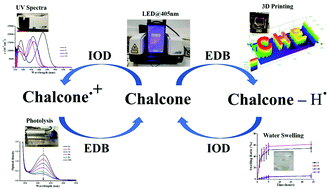Photoinitiators derived from natural product scaffolds: monochalcones in three-component photoinitiating systems and their applications in 3D printing†
Abstract
The design and development of high-performance photoinitiating systems applicable to visible light delivered from light-emitting diodes (LEDs) attract ever-increasing attention due to their great potential applications in various fields. Chalcones belong to a well-established class of natural compounds present in many plants. In this context, photoinitiators based on the scaffolds of natural compounds have probably great potential to open the way for non-toxic photoinitiators in the manufacturing of biocompatible polymer materials. In this work, 23 different chalcones selected from in silico molecular design (i.e. through molecular orbital calculations) were used in conjunction with an amine i.e. ethyl 4-(dimethylamino) benzoate (EDB) and an iodonium salt (bis-(4-tert-butylphenyl)iodonium hexafluorophosphate, Iod) to form photoinitiating systems (PISs) capable of initiating the polymerization of polyethylene glycol (600) diacrylate (PEG-diacrylate) via an oxidation–reduction reaction mechanism. The formation of hydrogels by the photopolymerization of PEG-acrylate is found to be very efficient. Remarkably, 10 of the 23 chalcones were completely new and even never synthesized prior to this work (chalcones 4, 5, 7, 8, 9, 10, 12, 15, 16 and 21). By using computational quantum chemistry, fluorescence, steady-state photolysis, and electron spin resonance spin-trapping techniques, the photoinitiation mechanism of three-component photoinitiating systems based on chalcones/Iod/EDB is clarified. The results demonstrate that several chalcone-based PISs can initiate free radical photopolymerization. Moreover, the developed chalcone-based three-component systems are applied to generate 3D hydrogel patterns using the 3D laser write technology. This research provides some novel insights into photopolymerization reactions with three-component photoinitiating systems used for 3D printing of hydrogels.



 Please wait while we load your content...
Please wait while we load your content...